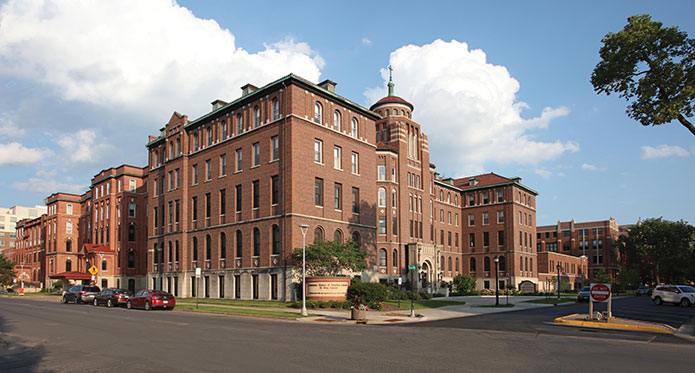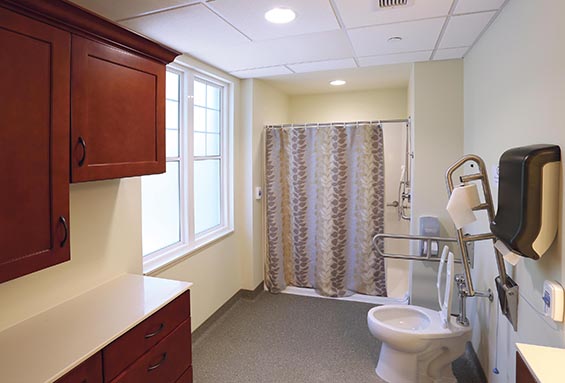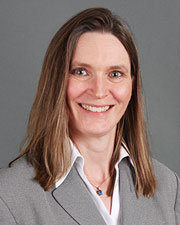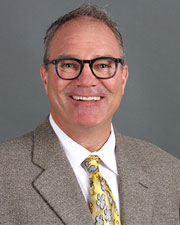Increasingly, senior living organizations are seeking to provide a combination of uses for a continuum of ages and care that is specific to each resident’s needs. While these aren’t new concepts, we’re seeing them rise higher on priority lists than ever before.
Modern care communities are being created to blend care efficiency with more nuanced treatment levels. While care options are becoming more specialized, we need to foster meaningful connections between those levels of community.
Mixed-Use, Multi-Generational Lifestyle Developments
A prime example can be found with the Franciscan Sisters of Perpetual Adoration (FSPA) in La Crosse, Wisconsin. This continuing care retirement community includes 45 skilled/memory care units along with 35 assisted living, 11 independent living/guest spaces, and 32 guest rooms for retreat center participants.
 The facility addresses the Franciscan Sisters’ vision of bringing sisters, spread across a wide continuum of care spectrum, together on one campus. Following a comprehensive planning effort, they decided to renovate St. Rose Motherhouse to accommodate all care levels and move those living off-site into the Motherhouse. The existing configuration was not readily suited to incorporate each of the needed levels of care, which presented a great renovation challenge and required a strong commitment from the sisters to bring their vision to life.
The facility addresses the Franciscan Sisters’ vision of bringing sisters, spread across a wide continuum of care spectrum, together on one campus. Following a comprehensive planning effort, they decided to renovate St. Rose Motherhouse to accommodate all care levels and move those living off-site into the Motherhouse. The existing configuration was not readily suited to incorporate each of the needed levels of care, which presented a great renovation challenge and required a strong commitment from the sisters to bring their vision to life.
Reflecting on why this renovation project was so important to FSPA, one of the sisters in leadership shared that it was part of how they enacted their assembly mandate to right-size their facilities, and it is vital to their future planning. She explained that they looked at their trends data knowing that they had two large buildings that were less than half full.
“We knew that as we moved forward, we would have fewer members and would not need both spaces,” she explained. “We realized it was not the best use of the assets we are stewarding to not use the buildings to their capacity. We discerned, as a congregation, that we wanted all of our senior members going forward—as space would permit—to be at our Motherhouse. That is where our adoration chapel is located, which is key to our charism of perpetual adoration.”
Responding to Changes in Health Care and Life Safety
In recent years, there has been a paradigm shift in care models, including a significant move to assisted living communities. Considering this swing, the solutions are not the same as they have historically been. Innovative design solutions are necessary to best meet the various care community being served. At times, regulations have not kept up with those needs, nor the research, best practices, new products, and special exceptions that will best serve the community.
Architectural and construction consultants must explore new ways to meet the intent of the code, even when those solutions are not explicitly permitted in the code. Existing codes can sometimes be years behind the continuum of care needs and solutions, so a Petition for Variance is requested in those situations.
 An example is the grab bar variance. Experience and research data is showing that swing-down grab bars can be more effective for residents and staff in assisted care environments. Unlike current code standards, swing-down grab bars are non-handed (correct for left or right-handed people), provide flexibility for residents with unbalanced upper body strength due to injuries or stroke, and permit additional flexibility for assistance.
An example is the grab bar variance. Experience and research data is showing that swing-down grab bars can be more effective for residents and staff in assisted care environments. Unlike current code standards, swing-down grab bars are non-handed (correct for left or right-handed people), provide flexibility for residents with unbalanced upper body strength due to injuries or stroke, and permit additional flexibility for assistance.
Petitions are sometimes the best way to provide effective design solutions, especially when repurposing existing buildings. Although a useful tool, petitions should not be taken lightly and always pursued in collaboration with all involved parties (owner, operator, care staff, plan reviewers, inspectors, state officials, etc.) to ensure the intended outcome is achieved.
Elevating the Staff Experience
Staff efficiency is at the top of the priority list for our senior living clients. Considering the staffing challenges that most organizations are facing, helping staff be more productive is a critical desired outcome.
Survey findings demonstrate that staff are one of the most important factors in environmental and care quality. Getting the most out of your staff is accomplished by improving their experience and creating a facility that allows them to work like they want to—smoother and easier.
This is accomplished by involving care givers, culinary staff, and other key stakeholders in early discussions to uncover the intricate details that will ultimately lead them to be fully successful in supporting patient care and independence.
Wellness Models for Active Older Adults
Never has wellness been as critical in senior living as it is today. Wellness encompasses many themes from physical fitness to social engagement. As providers navigate the wellness landscape in 2023, they are well served to take note of several trends and consider them as they are planning and making improvements to current wellness programs and paradigms.
We recommend the expansion of wellness programs to create deeper connections, higher levels of engagement, and more fulfilling experiences for residents and associates alike.
We have found that the expansion of wellness programs across the industry has enabled operators to offer more program customization without overwhelming their operations. One strategy for accomplishing this is to frontload the resident onboarding process with thorough evaluations that focus on lifestyle, preference, and resident history. It empowers operators and associates to create a more personalized experience for each resident. It also drives whole-person wellness by helping residents maintain physical activity, sense of purpose, and a feeling of connection.
We believe that every operator’s goal should be to create a greater sense of community. True communities are integrated and alive, providing residents with a greater sense of purpose, connection, and togetherness, and built around social engagement models. When the sense of community is the result of empowering residents, they become free to choose how they want to participate and contribute, instead of assuming the associates will do everything for them.
Use of Technology to Maintain Independence and Support Care Operations
We have had many conversations with clients about the increased and proper use of technology to make their work easier. You are likely very familiar with such applications as smart vital monitoring, fall detection, and social connectivity tools. These are still very proprietary, and interconnectivity with higher level systems like nurse call and security systems is sometimes limited.
The next shift and latest technology are happening more on the vendor level, versus the industry or system level. With that in mind, operators and administrators wishing to be on the forefront of technology advancement should engage with vendors that are on the cutting edge of specific systems. Then, they should seek to participate in beta tests to be a part of creating the end solutions that will serve residents and staff most effectively.
A crucial decision that we strongly encourage every client to make in a building project is to create a robust wired and wireless infrastructure. This will allow easier “plug and play” for the latest technological advancements, for emerging technologies, and most importantly, for future technologies yet to be developed.
Now and Then
Making decisions that allow for flexibility of care, staff efficiency, and wise use of technology will set you up for success. Your staff and residents will be the benefactors and the efficiency and productivity of your facilities will greatly benefit as well.

Julie Heiberger is a senior project architect and the Senior Living Market Leader for Hoffman Planning, Design & Construction, Inc. A member of the American Institute of Architects and the National Council of Architectural Review Boards, she received her Master of Architecture from the University of Wisconsin–Milwaukee.
 Randy Bremhorst is Vice President of Design at Hoffman Planning, Design & Construction, Inc. A graduate of the University of Notre Dame’s School of Architecture, he has more than 30 years of experience in the design and construction profession.
Randy Bremhorst is Vice President of Design at Hoffman Planning, Design & Construction, Inc. A graduate of the University of Notre Dame’s School of Architecture, he has more than 30 years of experience in the design and construction profession.